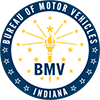Declared Gross Vehicle Weights
In Indiana, a vehicle’s plate weight is based on its declared gross vehicle weight. This weight is declared at the time of registration.
Indiana only uses the declared gross vehicle weight for the vehicle registration and plate weight. The vehicle’s declared gross vehicle weight or the plate weight don’t necessarily determine whether a commercial driver’s license (CDL) is required to operate the vehicle.
Declared gross vehicle weight depends on the type of vehicle being registered. Below is a list of each vehicle type and an explanation of how the declared gross vehicle weight is calculated.
- For-Hire Bus
Sum of the empty weight of the bus plus the product of the number of seats on the bus multiplied by 200 pounds.
Example: 25,000lbs (empty bus) + (20 seats x 200lbs) = 29,000 pounds
- Trailer
Sum of the empty weight of the trailer plus the weight of the heaviest load the trailer will carry during a registration year.
Example: 2,210lbs (empty trailer) + 5,290lbs (maximum trailer load) = 7,500 pounds
- Truck
Sum of the empty weight of the truck plus the weight of the heaviest load the truck will carry during a registration year. This does includes a truck camper that is installed on a truck, but it does not include the weight of a vehicle towed by a truck.
Example: 15,000lbs (empty truck) + 2,100lbs (maximum load) = 17,100 pounds
- Tractor Used with a Semi-Trailer
Sum of all of the following:
- the empty weight of the tractor,
- the empty weight of the heaviest semitrailer, or set of semitrailers, that the tractor will tow during a registration year,
- the heaviest load that the tractor will carry during a registration year,
- the heaviest load that will be carried by a semitrailer, or set of semitrailers, that the tractor will tow during a registration year.
Example: 8,660lbs (empty trailer) + 11,720lbs (empty weight of heaviest semitrailer) + 15,000lbs (heaviest load tractor will carry) + 60,000lbs (heaviest load carried by a semitrailer) = 95,380 pounds
When Do You Have to Register as a Commercial Vehicle?
A CDL is required to operate a commercial motor vehicle. A vehicle is considered a commercial motor vehicle by its gross vehicle weight rating and usage. The vehicle manufacturer determines the weight rating. The weight rating can be found on the inside of the vehicle’s door and does not vary depending on the use of the vehicle.
Federal law defines a commercial motor vehicle as a motor vehicle used in commerce to transport passengers or property. The motor vehicle must meet one of the qualifications below.
- Combination Vehicle (Group A)
A gross combination weight rating or gross combination weight of 11,794 kilograms or more (26,001 pounds or more), whichever is greater, inclusive of a towed unit(s) with a gross vehicle weight rating or gross vehicle weight of more than 4,536 kilograms (10,000 pounds), whichever is greater.
- Heavy Straight Vehicle (Group B)
A gross vehicle weight rating or gross vehicle weight of 11,794 or more kilograms (26,001 pounds or more), whichever is greater.
- Small Vehicle (Group C)
Does not meet Group A or B requirements, but is designed to transport 16 or more passengers, including the driver, or is used to transport hazardous materials.
The Federal Motor Carrier Safety Administration has provided the following example:
Question: A driver operates a tractor of exactly 26,000 pounds Gross Vehicle Weight Rating (GVWR), towing a trailer of exactly 10,000 pounds GVWR, for a GCWR of 36,000 pounds. Hazardous materials and passengers are not involved. Is it a Commercial Motor Vehicle (CMV)s and does the driver need a CDL?
Guidance: No to both questions. Although the vehicle has a Gross Vehicle Weight Rating (GVWR) of 36,000 pounds, it is not a Commercial Motor Vehicle (CMV) under any part of the definition of that term in 49 C.F.R.§383.5, and a CDL is not federally required.
Certain vehicles are also required to be issued United States Department of Transportation (USDOT) registration numbers based on their weight rating. Those numbers are handled by the Indiana Department of Revenue (DOR). For more information on USDOT numbering, visit DOR’s website or review their published Commercial Motor Vehicle Guidebook.
DOR Carrier Base Plate Registrations
Each year, the BMV identifies companies who have 5 or more commercial motor vehicle registrations. Those records are reviewed by the Department of Revenue – Motor Carrier Services (DOR-MCS) division to determine if they are required to register under DOR’s Base Plate Registration Program. Companies who are accepted by DOR-MCS will be notified and required to register the following vehicles with DOR-MCS by the following March 1.
- Trucks with a weight of 11,001 pounds or greater
- Semi tractors with a weight of 11,001 pounds or greater
- Recovery Vehicles
- Trailers with a weight of 9,001 pounds or greater
- Semitrailers
All other vehicles remain registered with the BMV.
If you have been notified by BMV and DOR that you are required to register vehicles under the Base Plate Program, please click on the following link to determine next steps.
International Registration Plan (IRP)
Individuals or companies involved in commercial interstate transportation that meet certain criteria may be eligible for the International Registration Plan (IRP). The IRP allows registered carriers to obtain one plate and registration cab card to travel in multiple states at specific weights. The program is managed by the Indiana Department of Revenue (DOR).
